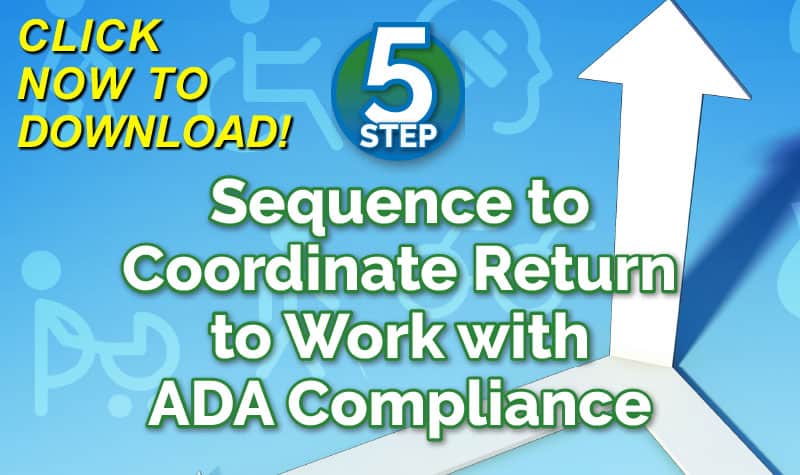
It is often the case that someone suffering from a work injury will have permanent limitations on their ability. This includes a loss in functional ability and earning power. Interested stakeholders should seek to offset these downfalls with services in their programs to get an injured employee back to work with as little time lost as possible, and with an earning capacity close to their pre-injury status. This can be accomplished by adding the following to their programs:
- Develop resource tools for injured employees that allow them to manage their money in an effective manner. This can include referral information to an independent financial planner, or other online planning resources.
- Other resources can include information on government benefit programs that may be available to them, along with other resources specifically in their community.
Click Link to Access Free PDF Download
“5-Step Sequence to Coordinate Return-to-Work with ADA Compliance”
Beyond MSAs – Dealing with Medicare
The aging workforce is dealing with more and more Medicare issues following the settlement of their workers’ compensation claim. Proactive stakeholders can help create peace of mind mitigate costs by directing injured employees to Medicare planning resources. These tools would include information on whether traditional Medicare (Medicare Parts A and B) is the best option, or in selecting a Medicare Advantage Plan, Medicare Part D (prescription drugs) Plan, or Medigap plan that is best.
Funds Administration Tools
Injured employees sometimes view the settlement as an opportunity to receive a quick lump sum payment. Studies indicate these settlements are often spent quickly, which leaves the injured employee with not enough economic resources to meet their post-injury needs. Proactive claim teams and others interested in the well-being of an injured employee can offer tools to help people accept a settlement and have a steady income flow into the future.
Structured settlements are one such tool that allows an injured employee to meet their future needs. Other benefits include:
- Creating a “win-win” for all parties involved;
- Free up allocated reserves that enable insurance carriers to settle other more troublesome claims; and
- Create an opportunity to use a broker to provide all stakeholders with fair and balanced financial planning advice.
Benefits of Life Care Planning Services
Life care planning is a specialized area that encompasses the practical experience of a trained professional to project future health care costs and provide guidance to all parties in a workers’ compensation claim. In order to accomplish this goal, the life care planner can:
- Utilize published standards of practice, research, and data analysis to project medical, non-medical, and psychosocial needs for the injured employee over their expected lifetime to calculate a realist medical cost projection for large loss claims; and
- When prepared by a certified life care planner, information in their reports can provide rebuttal information in settlement negotiations to assist a workers’ compensation program in finding fair and equitable value for a claim. This is especially the case in larger claims with significant losses, or smaller claims where the injured employee has unrealistic expectations.
Don’t Forget About Job Placement
Return-to-work efforts that are coupled with job placement is a significant step anyone can take who is interested in reducing workers’ compensation program costs, and mitigation exposure on claims. The important thing is to think outside the box when it comes to these matters. Considerations should include:
- Provide proactive placement assistance to individuals who are receiving Social Security Disability (SSDI), and utilize incentives to aid in their return to suitable gainful employment. One such program is the Ticket to Work program;
- Consider “work on loan” job placement opportunities with a local non-profit organization; or
- Develop a company “Return-To-Work Coordinator” who creates and oversees modified job placement within an employer.
Conclusions
Parties seeking to mitigate workers’ compensation program costs need to be creative and innovative. In doing so these stakeholders must view disability as “ability,” and develop services or use those in existence to promote settlement and add value to their claims resolution processes.

Contact: mstack@reduceyourworkerscomp.com.
Workers’ Comp Roundup Blog: https://blog.reduceyourworkerscomp.com/
©2020 Amaxx LLC. All rights reserved under International Copyright Law.
Do not use this information without independent verification. All state laws vary. You should consult with your insurance broker, attorney, or qualified professional.








